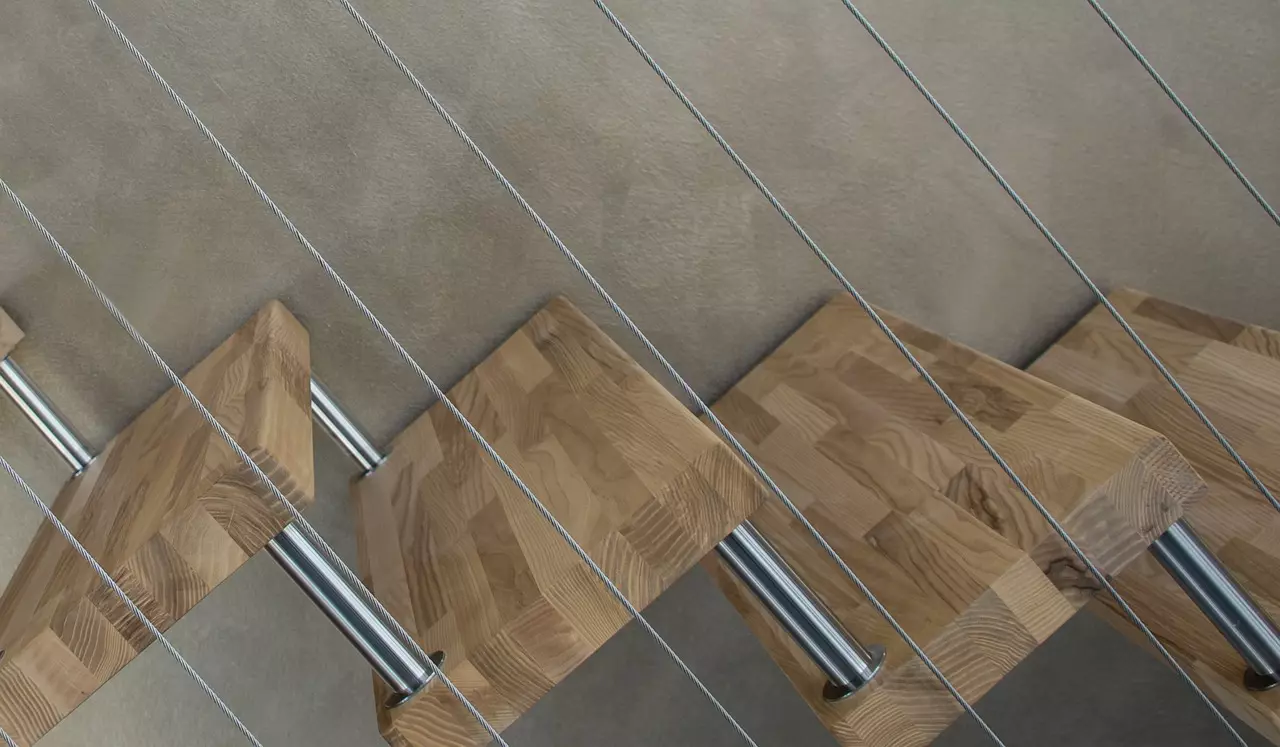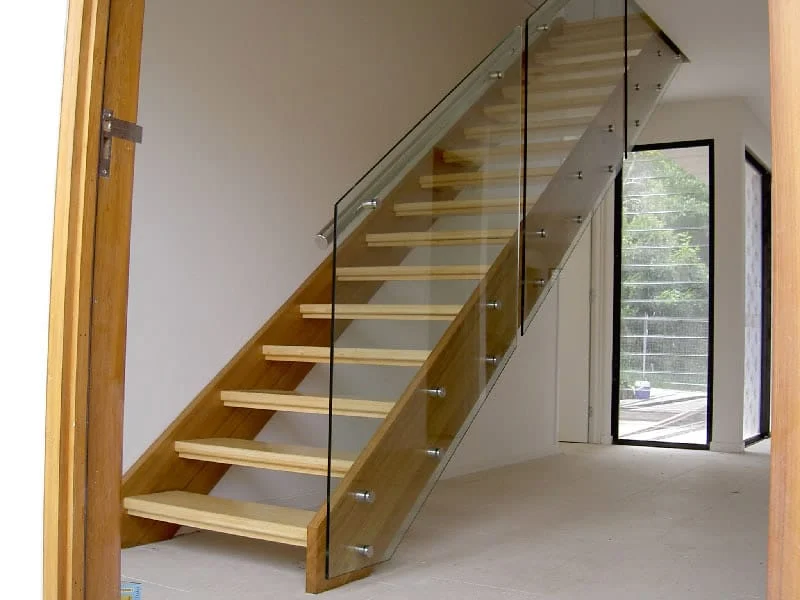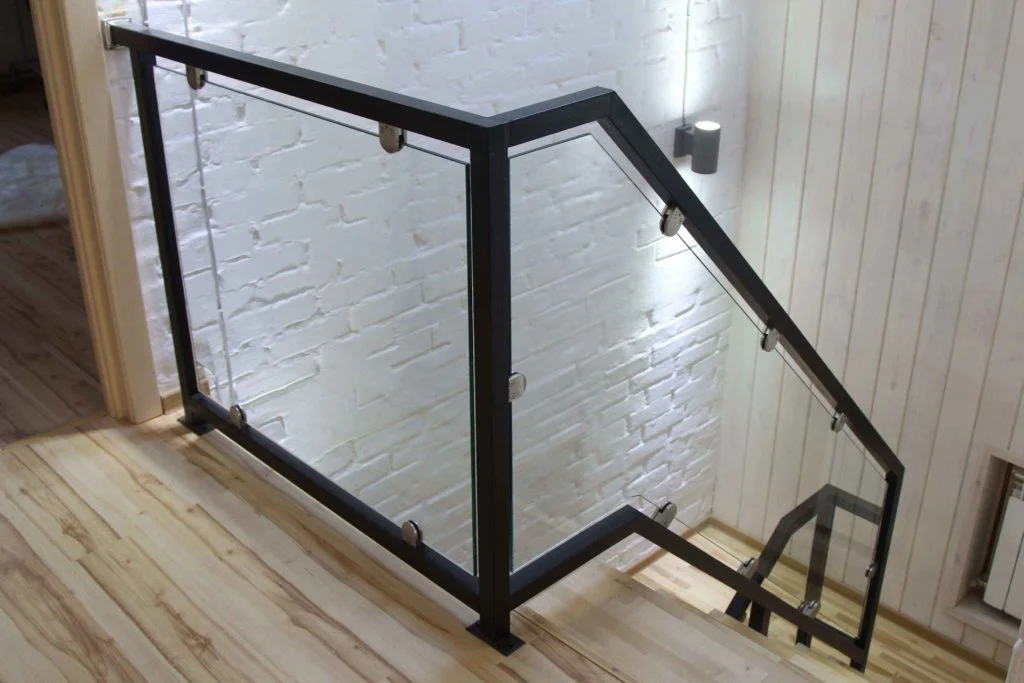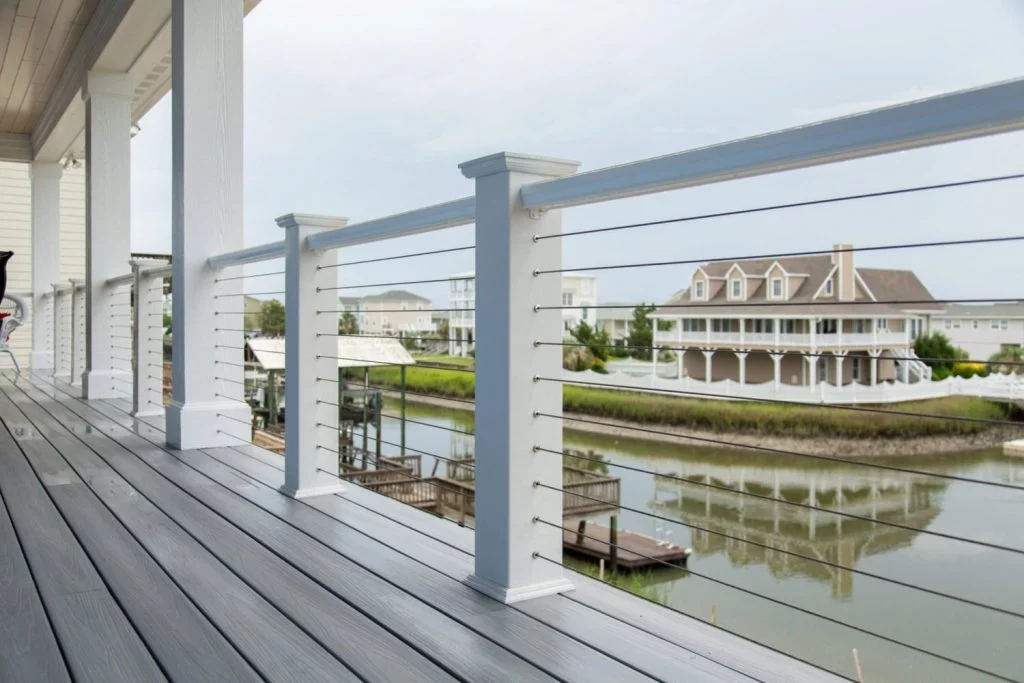
Essential Code Requirements for Cable Railing Spacing
Glass stair railing is used on various objects: in private houses, shopping complexes and office buildings. Such designs allow you to visually enlarge the room and make the interior more attractive. The main thing when installing such railings is to choose the right fasteners and carry out the installation.
Features, pros and cons
Glass canvases for stairs give the march a special elegance. Such designs are suitable for interiors in the Art Nouveau and futurism style. They are often equipped with additional lighting sources that allow you to highlight certain areas or create multicolored highlights.
A handrail made of metal or wood is installed on translucent railings. Externally, such designs look more representative.
There are certain requirements for glass panels for stairs. The main one is to preserve the safety of the residents of the house, so even with a large impact, no glass fragments are formed. The canvas is only covered with cracks.
Positive:
- the opportunity to install a stylish design in your home that will emphasize the features of the interior;
- no need to carefully monitor the cleanliness of the canvas. Glass does not need special care, cleaning is carried out as often as washing windows;
- resistance to UV, water, temperature changes;
- visual expansion of the room space;
- long service life;
- high safety — in the manufacture of such railings, special glass is used, which is not capable of causing injury in case of splitting.
When installing glass railings on the stairs, many design solutions open up. You can place an engraving or a self-selected image on the glass.
Handrails for stairs made of glass are made transparent or matte. The glass bends easily when using special equipment.
The disadvantages of glass structures include the high cost of the material. Some point to the fragility of glass in comparison with wooden or metal railings, but this disadvantage is relative.
Read also: 5 Reasons Why You Should Use Stainless Steel Railings
Types of constructions
Glass stair railings are produced in various configurations. Partitions can be fixed on racks or be self-supporting. Glass railings are distinguished depending on the method of fastening, material and method of manufacture.
According to the methods of fixing the glass
There are the following ways of fixing glass:
- Coin (also called point). This method of fastening got its name due to the appearance of the fixing elements – they resemble large coins. The glass is attached to the end of the stairs.
- Fastening with a clamping profile. With this installation option, the glass railings of the stairs are installed in special profiles placed at the bottom.
- With the help of connections. These are clamping fasteners that connect the frame of the railing with glass screens.
These are the main types of fasteners of glass railings. However, individually designed fixation elements are often used. The main thing is to choose something that will match the style of the interior.
Read also: The Differences Between Tempered & Laminated Glass
By glass material
Glass for stair railings is produced using technologies that allow achieving high strength, resistance to temperature and other useful properties. There are several main types of glass for railings.
Hardened
Such glass is subjected to heat treatment. As a result, it acquires positive properties:
- high temperature resistance;
- resistance to mechanical stress;
- high impact strength.
Heat treatment is performed at high temperatures, then the glass is cooled with air. When destroyed, it is not dangerous, since the fragments have blunt edges, and also have the shape of a trapezoid.
Tempered glass is made frosted, transparent or tinted. Such constructions are often decorated with a sandblasting machine.
Mollified
Molling allows you to obtain curved glass elements. Such structures are made by bending glass at high temperature on an all-metal mold. The bending radius is set arbitrarily.
Frost – resistant
Frost-resistant glass railings are used for external stairs. Such glass is not affected by low temperatures. It retains its strength and decorative properties even during severe frosts.
Triplex system
A commonly used variant of glass fencing is multilayer triplex systems. The structure consists of several elements glued together with a polymer film or adhesive composition. All components are connected into a single system. In the process of joining the canvases, they are pressed at high temperature.
Among the advantages of the triplex system are:
- high strength;
- operational safety;
- good heat resistance.
Since the material is decorated from the inside, the treated surface is completely protected from deformation during operation. Under severe mechanical stress, the structure does not disintegrate into fragments, but is held by a polymer film.
Plexiglass (polymethylmethacrylate)
Acrylic glass is often used in glass railings. It is made of whole sheets that do not have voids. Externally, such products resemble plexiglass. However, monolithic polycarbonate is inferior to it in terms of technical indicators. Plexiglass (plexiglass) has the following properties:
- high strength;
- fire resistance;
- durability.
In terms of strength, polymethylmethacrylate exceeds acrylic glass by 11 times. Plexiglass is made by extrusion or injection molding. Also, separate balusters and handrails are made in this way.
By frame type
Each railing has a frame and an inter-frame filling. Usually metal racks act as a supporting structure. Balusters are made of glass or wood. Install glass railings with or without a frame. In the latter version, the structure is self-supporting.
Read also: Modern vs. Traditional Stair Railings
Frameless (self-supporting) systems
Such structures are installed without a frame base. Usually the glass for them has a thickness of 13 to 19 mm. The glass is attached to the stairs at the base of the steps. To do this, use brackets, coin holders or a clamping profile.
Frameless glass railing with coin fastening
Frameless railings on the clamping profile
Such structures do not have support pillars. Handrails at the same time can:
- completely absent;
- be carried out beyond the plane of the railings;
- to be fixed on the upper edge of the canvas.
Special fasteners are used to install frameless structures. All-glass railings are fixed in metal or wooden profiles. In this case, the design acquires airiness.
Frame systems
The glasses in such structures are located between the support posts. The latter are attached to the steps. Usually, when installing the system, combinations of glass and other materials are chosen: wood, aluminum, stainless steel.
Frame structure with connections
Coin mount on the frame
Common variants of wireframes:
- full metal frame;
- the frame consists of small racks to which solid canvases are attached;
- metal racks with wooden handrails on top.
Advice! It is better to install ready-made elements yourself, from which modular structures are assembled.
Frame systems are easy to install, strong and durable, so they are often chosen for stair railings.
Decorative lighting
Glass railings for stairs are attractive in themselves. However, they are often equipped with decorative lighting. In this case, they become masterpieces of design art, capable of harmoniously complementing the interior.
Thanks to the illumination, stair railings acquire a spectacular appearance. Soft light sources ensure the safety of movement on the stairs with a glass railing at night. The illumination is installed on both indoor and outdoor structures.
Glass railings are decorated more often with LED, or LED, illumination. In this case, tapes are usually used, which are fixed to the handrail or at the edge of the railing. A popular option is with point light sources that can effectively illuminate the steps.
The color of the backlight is of particular importance. The classic white version is usually used. Often a blue or yellow shade is added to it. But it is better to choose the lighting of the stairs in accordance with the interior of the room in which the stairs are installed.
Read also: Are Floating Stairs Safe?
When installing a cable railing, adhering to proper cable railing spacing codes is important for both safety and compliance with building regulations. Cable railing systems must follow specific guidelines so they provide a secure barrier. Meeting essential code requirements helps ensure that cable railings are both functional and safe for every person in every setting they are installed in.
Are cable railings completely safe?
Cable railings are safe when properly installed and maintained according to building codes. One key safety factor is ensuring the correct cable railing post spacing. Additionally, the tension in the cables must remain tight enough to prevent deflection beyond safety standards. Stair handrails are another important element in cable railing systems, so users have proper support while ascending or descending stairs. When designed and installed following code requirements, cable railings can provide a safe and stylish alternative to traditional railing systems.
Read also: Deck Railing Colors Combinations: Creating a Cohesive Look for Your Deck
Code Compliance for Cable Railings
Cable railings must comply with building codes so they are both safe and function properly. Key requirements focus on aspects like the height of the railing, cable rail spacing, and the overall strength of the system. For residential applications, cable railing height typically needs to be at least 36 inches, while commercial applications may require a height of 42 inches.
The cable railing spacing code is also important, with most codes requiring gaps to be no larger than 4 inches to prevent children or objects from slipping through. Additionally, proper tensioning of the cables is also important to maintain this spacing and prevent sagging over time. Load-bearing capacity is another important factor, as railings must be able to withstand lateral and tension forces, especially in high-traffic or commercial areas.
Extending Cable Railings: Guidelines and Best Practices
When extending cable railings, adhering to specific guidelines is important for both safety and compliance. Considerations include maintaining proper tension in the cables, using durable materials, and following spacing guidelines. Posts should typically be spaced no more than 4 to 5 feet apart to prevent sagging and to maintain the required tension. When extending longer runs, it’s recommended to limit the cable length to around 70 to 90 feet to ensure proper tension. Additionally, when turning corners, it’s important to use double posts to prevent cable damage.
Proper post material, such as stainless steel or other durable metals, is also important for maintaining tension over time. Following these practices ensures that cable railing systems remain both safe and compliant, especially in longer or more complex installations. Also keep in mind that regular inspection and maintenance of the tension are very important to sustain the system’s functionality.
Glass stair railing is used on various objects: in private houses, shopping complexes and office buildings. Such designs allow you to visually enlarge the room and make the interior more attractive. The main thing when installing such railings is to choose the right fasteners and carry out the installation.
Features, pros and cons
Glass canvases for stairs give the march a special elegance. Such designs are suitable for interiors in the Art Nouveau and futurism style. They are often equipped with additional lighting sources that allow you to highlight certain areas or create multicolored highlights.
A handrail made of metal or wood is installed on translucent railings. Externally, such designs look more representative.
There are certain requirements for glass panels for stairs. The main one is to preserve the safety of the residents of the house, so even with a large impact, no glass fragments are formed. The canvas is only covered with cracks.
Positive:
- the opportunity to install a stylish design in your home that will emphasize the features of the interior;
- no need to carefully monitor the cleanliness of the canvas. Glass does not need special care, cleaning is carried out as often as washing windows;
- resistance to UV, water, temperature changes;
- visual expansion of the room space;
- long service life;
- high safety — in the manufacture of such railings, special glass is used, which is not capable of causing injury in case of splitting.
When installing glass railings on the stairs, many design solutions open up. You can place an engraving or a self-selected image on the glass.
Handrails for stairs made of glass are made transparent or matte. The glass bends easily when using special equipment.
The disadvantages of glass structures include the high cost of the material. Some point to the fragility of glass in comparison with wooden or metal railings, but this disadvantage is relative.
Read also: 5 Reasons Why You Should Use Stainless Steel Railings
Types of constructions
Glass stair railings are produced in various configurations. Partitions can be fixed on racks or be self-supporting. Glass railings are distinguished depending on the method of fastening, material and method of manufacture.
According to the methods of fixing the glass
There are the following ways of fixing glass:
- Coin (also called point). This method of fastening got its name due to the appearance of the fixing elements – they resemble large coins. The glass is attached to the end of the stairs.
- Fastening with a clamping profile. With this installation option, the glass railings of the stairs are installed in special profiles placed at the bottom.
- With the help of connections. These are clamping fasteners that connect the frame of the railing with glass screens.
These are the main types of fasteners of glass railings. However, individually designed fixation elements are often used. The main thing is to choose something that will match the style of the interior.
Read also: The Differences Between Tempered & Laminated Glass
By glass material
Glass for stair railings is produced using technologies that allow achieving high strength, resistance to temperature and other useful properties. There are several main types of glass for railings.
Hardened
Such glass is subjected to heat treatment. As a result, it acquires positive properties:
- high temperature resistance;
- resistance to mechanical stress;
- high impact strength.
Heat treatment is performed at high temperatures, then the glass is cooled with air. When destroyed, it is not dangerous, since the fragments have blunt edges, and also have the shape of a trapezoid.
Tempered glass is made frosted, transparent or tinted. Such constructions are often decorated with a sandblasting machine.
Mollified
Molling allows you to obtain curved glass elements. Such structures are made by bending glass at high temperature on an all-metal mold. The bending radius is set arbitrarily.
Frost – resistant
Frost-resistant glass railings are used for external stairs. Such glass is not affected by low temperatures. It retains its strength and decorative properties even during severe frosts.
Triplex system
A commonly used variant of glass fencing is multilayer triplex systems. The structure consists of several elements glued together with a polymer film or adhesive composition. All components are connected into a single system. In the process of joining the canvases, they are pressed at high temperature.
Among the advantages of the triplex system are:
- high strength;
- operational safety;
- good heat resistance.
Since the material is decorated from the inside, the treated surface is completely protected from deformation during operation. Under severe mechanical stress, the structure does not disintegrate into fragments, but is held by a polymer film.
Plexiglass (polymethylmethacrylate)
Acrylic glass is often used in glass railings. It is made of whole sheets that do not have voids. Externally, such products resemble plexiglass. However, monolithic polycarbonate is inferior to it in terms of technical indicators. Plexiglass (plexiglass) has the following properties:
- high strength;
- fire resistance;
- durability.
In terms of strength, polymethylmethacrylate exceeds acrylic glass by 11 times. Plexiglass is made by extrusion or injection molding. Also, separate balusters and handrails are made in this way.
By frame type
Each railing has a frame and an inter-frame filling. Usually metal racks act as a supporting structure. Balusters are made of glass or wood. Install glass railings with or without a frame. In the latter version, the structure is self-supporting.
Read also: Modern vs. Traditional Stair Railings
Frameless (self-supporting) systems
Such structures are installed without a frame base. Usually the glass for them has a thickness of 13 to 19 mm. The glass is attached to the stairs at the base of the steps. To do this, use brackets, coin holders or a clamping profile.
Frameless glass railing with coin fastening
Frameless railings on the clamping profile
Such structures do not have support pillars. Handrails at the same time can:
- completely absent;
- be carried out beyond the plane of the railings;
- to be fixed on the upper edge of the canvas.
Special fasteners are used to install frameless structures. All-glass railings are fixed in metal or wooden profiles. In this case, the design acquires airiness.
Frame systems
The glasses in such structures are located between the support posts. The latter are attached to the steps. Usually, when installing the system, combinations of glass and other materials are chosen: wood, aluminum, stainless steel.
Frame structure with connections
Coin mount on the frame
Common variants of wireframes:
- full metal frame;
- the frame consists of small racks to which solid canvases are attached;
- metal racks with wooden handrails on top.
Advice! It is better to install ready-made elements yourself, from which modular structures are assembled.
Frame systems are easy to install, strong and durable, so they are often chosen for stair railings.
Decorative lighting
Glass railings for stairs are attractive in themselves. However, they are often equipped with decorative lighting. In this case, they become masterpieces of design art, capable of harmoniously complementing the interior.
Thanks to the illumination, stair railings acquire a spectacular appearance. Soft light sources ensure the safety of movement on the stairs with a glass railing at night. The illumination is installed on both indoor and outdoor structures.
Glass railings are decorated more often with LED, or LED, illumination. In this case, tapes are usually used, which are fixed to the handrail or at the edge of the railing. A popular option is with point light sources that can effectively illuminate the steps.
The color of the backlight is of particular importance. The classic white version is usually used. Often a blue or yellow shade is added to it. But it is better to choose the lighting of the stairs in accordance with the interior of the room in which the stairs are installed.
Read also: Are Floating Stairs Safe?

Cable Railing Post Spacing: Key Considerations
Cable railing post spacing is important for both the look and structural integrity of the system. Typically, posts should be spaced no more than 4 to 5 feet apart to maintain proper tension in the cables. This spacing helps prevent the cables from sagging over time and ensures the system meets building code requirements, which generally require that the gaps between cables do not exceed 4 inches. Proper post spacing also helps maintain the structural integrity of the railing. Using strong, durable materials like stainless steel for the posts help to support the tension of the cables over time.
Stylish Cable Railings That Adhere to Building Codes
Here are some stylish cable railing ideas that adhere to cable railing code requirements:
- Stainless Steel Cable with Wood Posts. Combining stainless steel cables with wood posts offers both a modern and rustic look.
- Glass and Cable Combo. Adding glass panels between the cable sections creates a contemporary, open feel while providing extra safety and wind protection. A railing contractor can ensure this setup meets safety standards.
- Black Metal and Cable Railings. Black metal posts paired with stainless steel cables offer an industrial style that mixes well with urban or modern architecture, while still being compliant.
- Horizontal Cable with Custom Finishes. You can add unique finishes, like matte black or bronze, to metal posts for a custom look that complements your outdoor space, while still being compliant and sturdy enough for everyday use.
These designs balance style with compliance, providing both safety and stunning look.
Read also: How to Choose the Best Top Rail for Your Deck: 5 Key Factors
-
Erika Baldwin was born in Bogotá, Colombia, and graduated from Liceo Boston in 2000. She studied Design at Universidad Nacional de Colombia. Starting her career as a model in 1998 with agencies in Colombia and Miami, Florida, Erika later transitioned to real estate, working with EWM Realtors, Prudential Realty, Berkshire Hathaway HomeServices with the Denise Rubin Group, and Isler Realty. She currently holds a real estate license with Century 21 in Wellington, Florida. As the General Manager of Luxury Staircase Railings, Erika is passionate about creating handrail systems that go beyond functionality — designed to reflect the unique style and character of every building. She works closely with her clients to bring their visions to life, ensuring each project is tailored to their specific needs. For handrails that combine safety with elegant design, Erika Baldwin is the trusted expert.
View all posts

























